This article will cover the more mature RWA projects in MakerDAO.
Author: Will Awang

Real-world assets exist off-chain, and asset owners can expect to receive returns from them. The related ownership benefits are regulated by the legal system and rooted in our social contracts. For on-chain DeFi that adheres to the principle of "Code is Law," it is currently necessary to explore and solve the issue of adapting off-chain governance systems and legal frameworks to help secure encrypted capital to capture off-chain assets in a compliant manner.
Following the previous exploration of the path for on-chain assets through Centrifuge, this article will, from the perspective of MakerDAO's DeFi, outline the governance system, legal framework, and practical path for capturing off-chain assets in a decentralized manner. We hope this will be helpful for project parties and builders involved in RWA, and we welcome discussions and exchanges at any time.
This article will cover the more mature RWA projects in MakerDAO, such as New Silver Restructuring, BlockTower Credit, BlockTower Andromeda, Monetalis Clydesdale, and the transaction architecture provided by Centrifuge for Aave.
I. Why DeFi Needs to Capture Real-World Assets
The narrative of RWA can also be seen as the narrative of MakerDAO's DeFi, and it is essential to consider the significance of RWA for the DeFi world from the perspective of MakerDAO.
MakerDAO is a decentralized autonomous organization (DAO) aimed at managing the operation of the Maker protocol on Ethereum. The protocol provides the first decentralized stablecoin DAI (which can be simply understood as the dollar on Ethereum) and a range of derivative financial systems. Since its launch in 2017, DAI has always been pegged to the dollar.
During the DeFi Summer of 2021, numerous unsustainable DeFi yield products led to a major collapse in the crypto market, spreading credit defaults throughout the ecosystem. Although native crypto assets are a key component of DeFi and a long-term differentiating factor, the current real-world demand does not match the long-term development value.
Due to the high volatility of the cryptocurrency market, relying on a single collateral asset may lead to a large number of liquidations. For giant lending protocols like MakerDAO, a key consideration is the stability of collateral value. We have seen that previously, MakerDAO's collateral included volatile crypto assets, which posed risks to lending and severely limited MakerDAO's room for development.
Therefore, MakerDAO or DeFi urgently needs a more stable underlying layer of collateral to support the widespread adoption of the stablecoin DAI in the crypto world, building a sustainable and scalable path.

(Centrifuge & Maker: A Partner's View of Real-World Assets)
RWA, as one of the most important topics for MakerDAO, is constantly being discussed and validated by the community and is seen as an important solution. In MakerDAO's Endgame plan released in May 2022, it also emphasizes that one of the key parts of building a decentralized stablecoin for MakerDAO is to use RWA as collateral.
The benefits of RWA include:
(1) Increasing transparency of market risks and asset usage; (2) Providing composability for DeFi; (3) Improving accessibility for underserved banking services and underfunded populations; (4) Capturing value from larger and more stable traditional financial markets.
For MakerDAO, RWA has two important characteristics—stability and scalability. Furthermore, DAI can expand its usage by anchoring stable, interest-bearing, and scalable assets without crypto volatility, especially in the current market environment with low crypto asset yields and high US Treasury yields. Through the value capture of RWA, MakerDAO can continue to expand and grow in a bear market and be well prepared for the next bull market cycle.
Most importantly, RWA can help MakerDAO achieve its grand vision: to allow for a credit-neutral, decentralized channel to increase utility for people's daily lives and business development needs. This will be achieved through an open, on-chain, community-driven, programmable, and decentralized protocol to create a brand-new open DeFi financial market.
However, bringing real-world assets on-chain is not easy and involves challenges in new product architecture design, financial, legal compliance, and technical risks, as well as unknown unknowns.
II. How DeFi Captures Real-World Assets
After clarifying the need for DeFi to capture real-world assets, it is necessary to establish governance systems and legal frameworks suitable for on-chain protocols or DAO organizations. Of course, some may say that this operation is unnecessary and that it is sufficient to directly purchase tokenized US Treasury bonds issued by third parties, saving time and effort.
For example, we have seen very successful on-chain fund projects on the market—Solv Protocol, which launched two RWA funds in its V3 version. Managed by Solv RWA, the funds currently manage a total of $2 million TVL in assets, and qualified users can deposit stablecoins to enjoy the returns of US Treasury bonds through KYC/AML. According to their press release, the underlying assets of this RWA fund are provided by Red Cedar Digital. Ltd. in the form of tokenized US Treasury bonds.

(Solv V3’s Milestone Achieved: The First Ever RWA Fund Launch)
For projects with small fund sizes and under controllable/affordable risks, it is possible to directly purchase tokenized US Treasury bonds provided by third parties without any issues. However, we still need to consider several questions:
(1) How to ensure that the counterparty providing the underlying assets (Red Cedar Digital. Ltd.) will not go bankrupt and run away? Think about the once-thriving FTX; (2) Furthermore, after the counterparty goes bankrupt, how can this on-chain protocol without a legal entity participate in asset liquidation/restructuring as a creditor in court?
Although it may be costly for DeFi projects to build their own governance systems and legal frameworks, this is a hedge against risks. In any case, this does not prevent us from exploring and studying successful RWA cases in the market to make choices that suit our own needs.
2.1 The Necessity of Legal Packaging for DeFi
As a MakerDAO with a RWA fund volume of several billion US dollars, it has considered identifiable risks from both a fund security perspective and a legal entity qualification perspective. These risks come from: counterparty risk. Imagine the case of a counterparty going bankrupt or running away. MakerDAO needs to ensure that any third party (including fund managers/investment advisors) does not have the ability to directly control, dispose of, or transfer its substantial funds; legal entity authentication. On-chain protocols or DAO organizations cannot complete the customer identification authentication (KYC/AML) required to legally purchase and hold off-chain assets. Similarly, they cannot hold their own IP assets; bankruptcy liquidation qualification. Once there is a default, bankruptcy, or liquidation of off-chain assets, as the on-chain protocol or DAO is not a legal entity, it cannot immediately interact with real-world courts or liquidation institutions. Therefore, it is necessary to ensure that MakerDAO has the ability to exercise its rights to dispose of off-chain assets through governance systems and legal frameworks.

(The DAO Legal Wrappers and why you need them)
2.2 How DeFi Engages in Legal Wrapping
Legal wrapping is a collection of legal frameworks or legal entities specifically designed for on-chain protocols or DAO organizations, providing them with a recognized legal status in relevant jurisdictions. Its essence is to "wrap" on-chain protocols or DAO organizations within a legal framework or "establish" a legal framework, thereby connecting with the real world and enabling on-chain protocols or DAO organizations to interact with traditional legal systems.
Legal wrapping does not absorb or replace the on-chain operation of protocols or DAO organizations; it simply transfers some of their functions and responsibilities to the legal entity of the DAO, allowing them to obtain legal protection in the relevant jurisdiction, manage tax and regulatory obligations, sign contracts, own assets, make statutory payments, and engage in real-world interactions. The DAO and multi-signature wallets retain direct control over smart contracts, treasuries, and any on-chain assets and only provide funds to their legal wrapped entities when needed.
From the perspective of RWA, we can establish a corresponding legal entity for on-chain protocols or DAO organizations for the specific purpose of capturing the value of off-chain assets.
2.3 How DeFi Governs Off-Chain Legal Entities
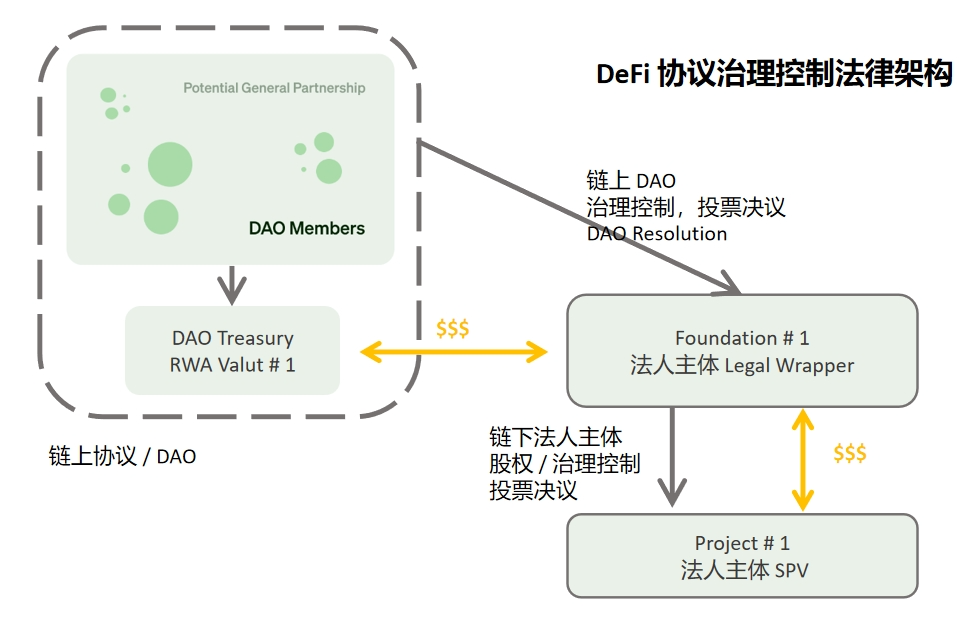
We will further explain this with the current practice of MakerDAO, which has the largest volume of RWA assets.
The above image shows the Foundation + SPV architecture established specifically for RWA projects according to MakerDAO MIP58 proposal, aiming to capture the value of underlying RWA assets through governance control of the Foundation's legal entity.
First, MakerDAO established the RWA Foundation #1 as a foundation under the Cayman Islands Foundation Company Law of 2017, providing a flexible governance framework for on-chain protocols or DAO organizations.
Internally, the foundation, as a legal entity, does not require any registered capital or shareholder/member roles, making it a single-purpose independent orphan legal entity. The foundation can also act as a trust, designating MakerDAO or its members as beneficiaries. Additionally, the foundation can achieve bankruptcy remoteness, ensuring that the bankruptcy of MakerDAO or the foundation will not affect each other. Externally, as a legal entity, the foundation can:
(1) Interact with off-chain entities, such as signing contracts and providing services; (2) Legally hold off-chain assets/IP through KYC/AML; (3) Protect the limited liability of DAO members; (4) Execute a series of off-chain operations on behalf of the DAO according to DAO resolutions.
Secondly, the legal entity of the foundation can tailor a governance system for MakerDAO based on its articles of association, memorandum of association, and other organizational documents, such as specifying that it will only execute resolutions made by MakerDAO and will not make any resolutions or execute them itself. It can appoint supervisors and directors with fiduciary duties according to the foundation's organizational documents/granted authority to ensure that MakerDAO has complete control at the legal entity governance level.
Finally, according to MakerDAO's resolution, Foundation #1, as an independent orphan holding company, holds equity interests in the subsidiary SPV #1 legal entity. SPV #1 is established in the local jurisdiction of the off-chain assets and captures the off-chain assets with funding from Foundation #1 through a loan agreement signed with MakerDAO, for example, setting up a Delaware LLC as the SPV to hold off-chain assets if the assets are located in the United States.
Although we can also see governance systems and legal frameworks of SPV + trust in some other projects, the overall principles are:
(1) Ensure governance control of on-chain protocols or DAO organizations; (2) DAO organizations/tokenholders as beneficiaries; (3) Legal, effective, and timely disposal of assets by the wrapped legal entity.
III. MakerDAO's RWA Practice Cases
Since participating in the Solar X energy project financing, MakerDAO has gradually developed a RWA path suitable for DeFi through practice, achieving the capture of off-chain assets through the legal wrapping of DeFi (Foundation + SPV or Trust) and maintaining the essence of transaction structures.
The following are some successful RWA projects of MakerDAO for reference, including New Silver Restructuring, BlockTower Credit, BlockTower Andromeda, Monetalis Clydesdale, and the transaction architecture provided by Centrifuge for Aave.
3.1 MakerDAO—New Silver Restructuring (Credit Asset RWA)
New Silver is likely MakerDAO's first formal RWA project, established in 2021, with a debt ceiling of $20 million. The underlying assets are mortgage loans initiated by New Silver, financed through tokenization on the Centrifuge platform by the issuing entity SPV set up by New Silver.
In November 2022, the community proposed an upgrade and restructuring of the 2021 New Silver project, which fully adopted the above Foundation + SPV transaction architecture, making it a textbook-like practice.

In the New Silver Restructuring upgrade and restructuring transaction architecture, the main participants include:
RWA Foundation, established in 2021, which operated the previous HunTINgdon Valley Bank (HVB) project and is governed by MakerDAO—stipulating in the governance documents that the Foundation Director must make any resolutions or exercise any rights according to MakerDAO Resolutions. Thus, through the on-chain governance of MakerDAO and the off-chain governance of the Foundation, MakerDAO ensures complete control at the legal entity governance level.
NS DROP Ltd, as a wholly-owned subsidiary of the RWA Foundation, is the executing entity of this transaction, participating in the subscription of DROP tokens initiated by Centrifuge for the financing party and providing funds. It acts as the token holder representative (DROP/TIN) and exercises the relevant rights delegated by MakerDAO Resolutions. It also instructs the trustee, Ankura Trust, to perform a series of asset operations.
Ankura Trust is responsible for ensuring the independence of the issuer SPV's assets and the security of MakerDAO's funds. According to the trust agreement between the issuer SPV and the trust company, it stipulates the mortgage of SPV credit assets and the pledge of SPV's equity to ensure the integrity of MakerDAO's assets and timely and full disposal in the event of default, providing security for MakerDAO's funds.
3.2 MakerDAO—BlockTower Credit (Credit Asset RWA)
BlockTower Credit is a credit asset tokenization project initiated by BlockTower Capital, implemented in November 2022, with a total debt ceiling of $150 million divided into 4 asset pools. BlockTower Credit, as the asset initiator, finances through its issuing entity SPV on the Centrifuge tokenization platform.
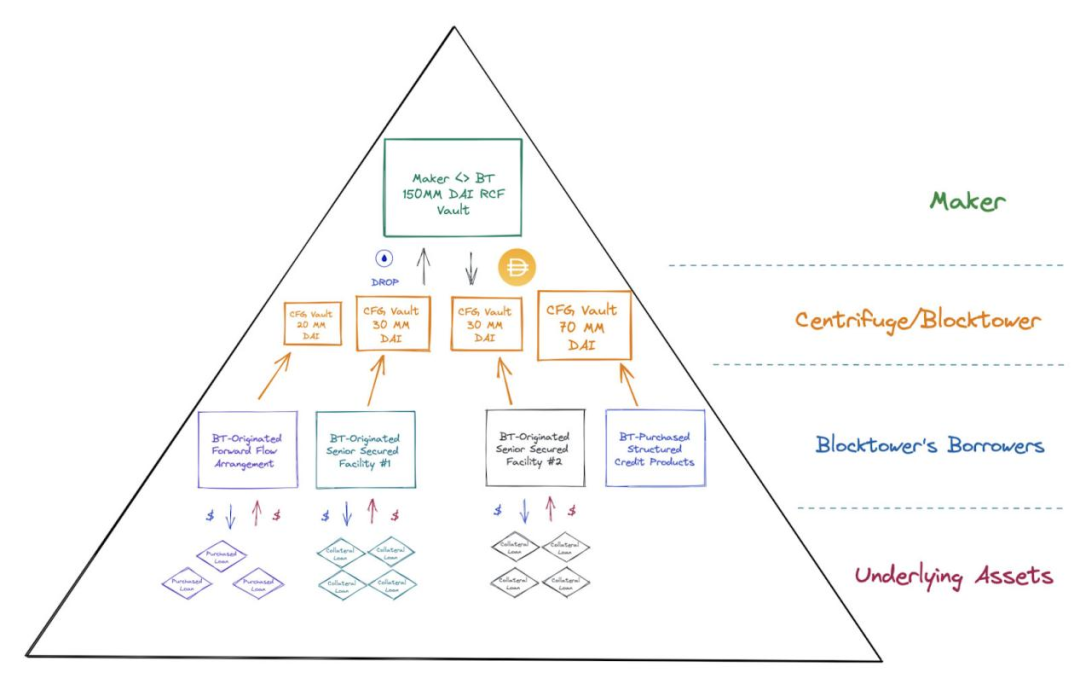
(BlockTower Credit - Commercial and Legal Risk Assessment - Part I)
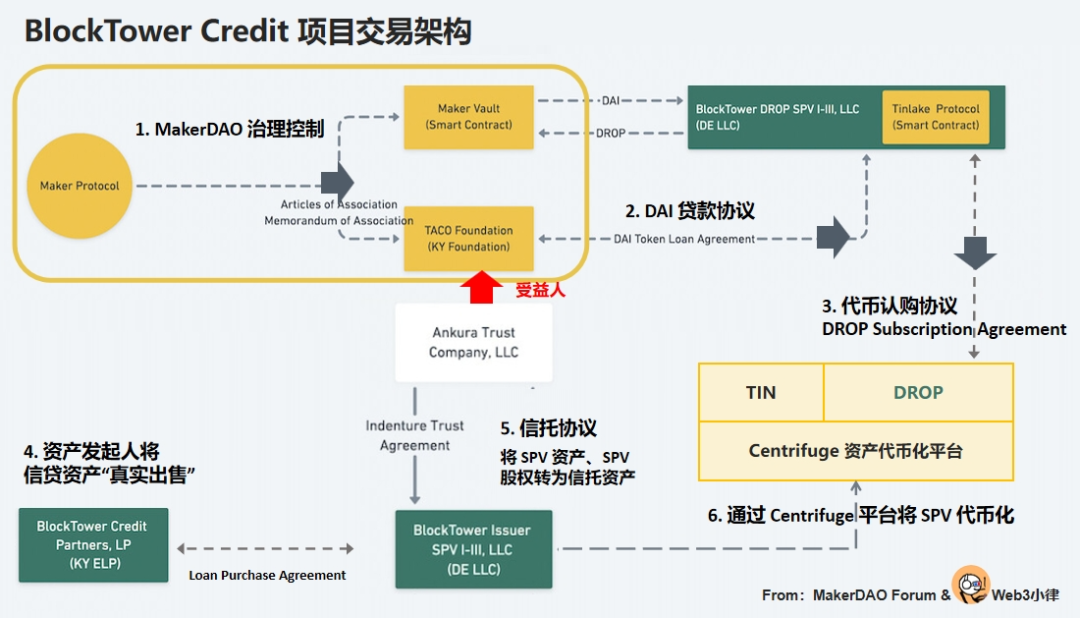
The transaction architecture of BlockTower Credit is similar to New Silver Restructuring. We further break it down into two parts: the fund-side operation, i.e., how to securely and compliantly convert on-chain assets to off-chain while still under MakerDAO's control, and the asset-side operation, i.e., how to tokenize off-chain assets and obtain funding from MakerDAO.
From the DeFi perspective of MakerDAO:
MakerDAO first controls the TACO Foundation through governance (TACO Foundation, like RWA Foundation, is governed by MakerDAO).
Through the loan agreement between TACO Foundation and Blocktower DROP SPV, MakerDAO provides its DAI funds, using DROP tokens as collateral.
This portion of the funds is used to subscribe to DROP tokens on the Centrifuge platform, which are issued by the issuer SPV holding Blocktower's underlying assets.
From the asset financing perspective:
BlockTower Credit Partners, as the asset initiator (Originator), transfers credit assets into the issuer SPV through "true sale."
To ensure the independence of the issuer SPV's assets and the security of MakerDAO's funds, the issuer SPV enters into a trust agreement with Ankura Trust, stipulating the mortgage of SPV credit assets and the pledge of SPV's equity, with the beneficiaries being the holders of DROP/TIN tokens (i.e., TACO Foundation), ensuring the integrity of MakerDAO's assets and timely and full disposal in the event of default, providing security for MakerDAO's funds.
The issuer SPV issues DROP and TIN tokens through the Centrifuge asset tokenization platform, with DROP as the senior token subscribed by TACO through the above channels, and TIN tokens as the junior token subscribed by BlockTower Credit Partners.
3.3 MakerDAO—BlockTower Andromeda (US Treasury RWA)
BlockTower Andromeda is one of the largest RWA projects of MakerDAO, with a debt ceiling of $1.28 billion and current assets exceeding $1 billion. It is a US Treasury RWA project initiated by BlockTower Capital and executed through the TACO Foundation, aiming to diversify treasury funds and invest in off-chain US treasuries.
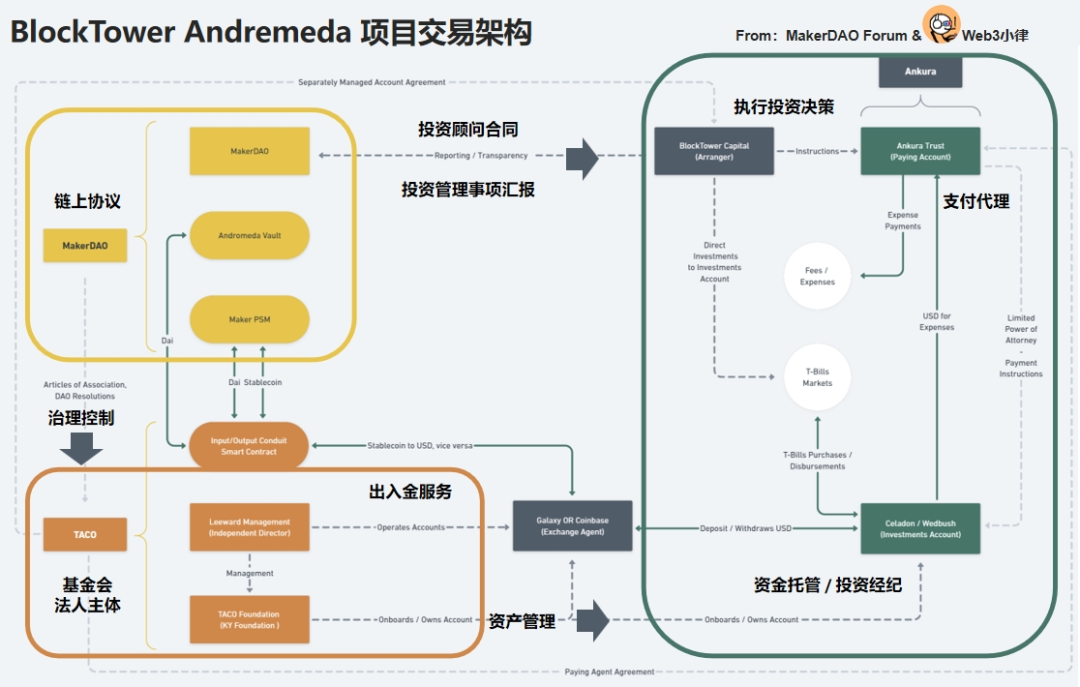
In the project architecture of BlockTower Andromeda, the main participants include:
TACO Cayman Foundation, established in 2022, which operated the previous BlockTower S3/S4 credit asset RWA project with a fund size limit of $150 million. Like the RWA Foundation, this foundation is governed by MakerDAO and, according to Article 4.16 of the foundation's articles of association, the Foundation Director must make any resolutions or exercise any rights according to MakerDAO's governance votes (MakerDAO Resolutions).
BlockTower Capital, as the investment advisor for this project, has signed an investment advisory contract with TACO Foundation, responsible for managing the funds of various accounts of TACO Foundation and making investment decisions. Coinbase and Galaxy Digital serve as fund service providers, Celadon Financial Group as a broker executing investment advisor decisions, Wedbush Securities Inc. as the fund custodian, and Ankura Trust as the payment agent.
In this architecture, MakerDAO uses the TACO Foundation as a legal contracting entity to carry out off-chain investment-related matters and separates investment decisions and asset custody in the traditional financial sense to achieve risk control and compliance.
In comparison to the BlockTower Credit project, we see the same point: at the DAO governance level, both projects use the system of MakerDAO's on-chain governance and the Foundation's off-chain governance to ensure complete control at the legal entity governance level for MakerDAO.
The difference is that at the level of capturing the underlying asset value, Andromeda directly invests funds in US Treasury assets through fund services, investment advisors, investment brokers, fund custody, and payment agents, through the form of the TACO Foundation. On the other hand, the BlockTower S3/S4 project, due to the different underlying assets, incorporates a foundation and SPV structure, with the SPV specifically used to capture the underlying assets tokenized through the Centrifuge platform.
3.4 MakerDAO—Monetalis Clydesdale (US Treasury RWA)
Although we have seen several successful projects operated by MakerDAO within Blocktower, there are still concerns about the concentration of counterparties, such as Blocktower playing multiple important roles in the projects, such as investment advisors and asset initiators.
Therefore, the Monetalis Clydesdale project, initiated by Monetalis founder Allan Pedersen, aims to explore a safer RWA path. The project was proposed in January 2022, approved and executed in October 2022, with an initial debt ceiling of $500 million, increased to $1.25 billion in May 2023, and the assets invested in US Treasury ETFs.
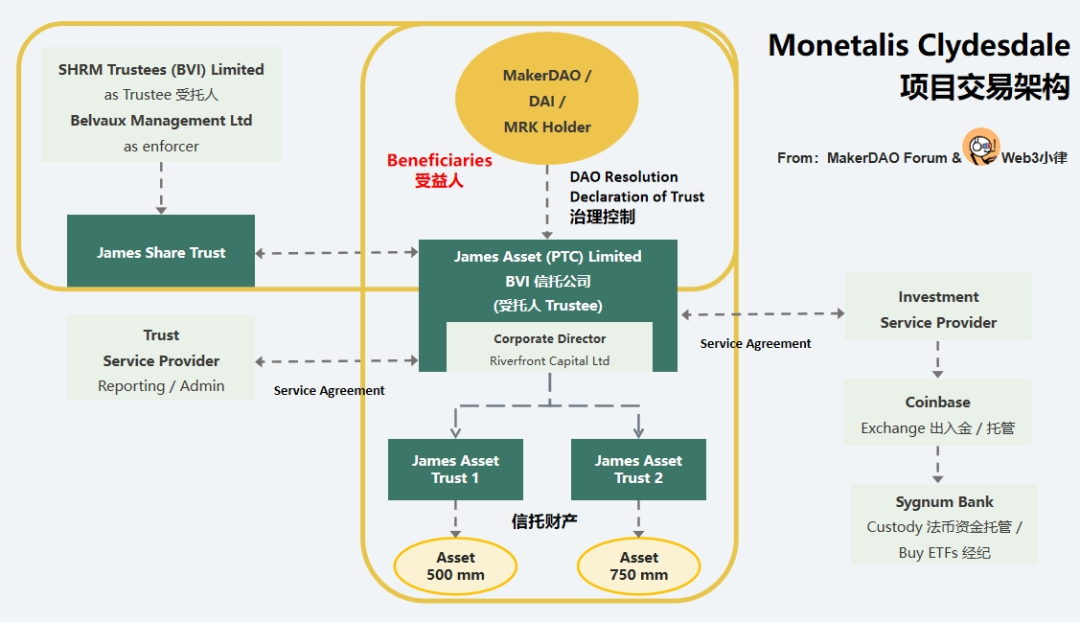
In the transaction architecture of Monetalis Clydesdale, the fund-side operation is crucial, i.e., how to securely and compliantly convert on-chain assets to off-chain while still under MakerDAO's control:
Establishment of Property Trust. First, establish a BVI trust company named JAL, which sets up the James Asset Trust through a Declaration of Trust. JAL, as the trustee, holds the DAI/ETF trust assets provided by MakerDAO, with MakerDAO MKR token holders as beneficiaries, controlling the trustee through the trust governance documents, instructing the purchase and disposal of trust assets. MakerDAO's governance control: According to the Declaration of Trust, the trustee JAL must take any action based on MakerDAO Resolutions; any action must be approved and agreed upon by the transaction manager's MakerDAO Resolution; the trustee JAL must not take any action unrelated to MakerDAO Resolution. Establishment of Equity Trust. After handling the governance control of the trustee JAL's trust property by MakerDAO, the equity of the trustee JAL needs to be established as trust property in the James Asset Share Trust, with SHRM Trustees (BVI) Limited as the trustee, Belvaux Management Ltd as the enforcer, and MakerDAO MKR token holders as beneficiaries. Thus, MakerDAO achieves control over the JAL trust property (corresponding to the DAI trust assets provided by MakerDAO) and also over the JAL's equity (corresponding to the trustee JAL). In this case, any operation requires validation through MakerDAO Resolution, and the flow of funds does not go through any third-party control (MakerDAO Vault - JAL Trust Property Custody Account - Sygnum Bank Custody Account). In this transaction architecture, MakerDAO achieves: 1) less or no counterparty risk, i.e., third parties or investment managers have no ability to change legal terms or access related funds; 2) unimpeded on-chain and off-chain governance structure; 3) trust protection to ensure that MakerDAO MKR token holders have the ability to timely handle default relief and liquidation risks of underlying assets; 4) clear and fixed use of funds, and no risk of misappropriation, etc.
Next, the trustee JAL's asset investment is relatively straightforward, converting DAI into USD through Coinbase and conducting fund custody and ETF trading through Sygnum Bank.
3.5 Centrifuge—RWA Roadmap (US Treasury RWA)
Centrifuge has been involved in several previous credit asset RWA projects operated by MakerDAO, such as the New Silver Restructuring and BlockTower Credit mentioned above. The specific process is not elaborated here, but those interested can read our previous analysis of Centrifuge in the article "Decentralized Asset Financing Protocol Centrifuge from the Essence of RWA."
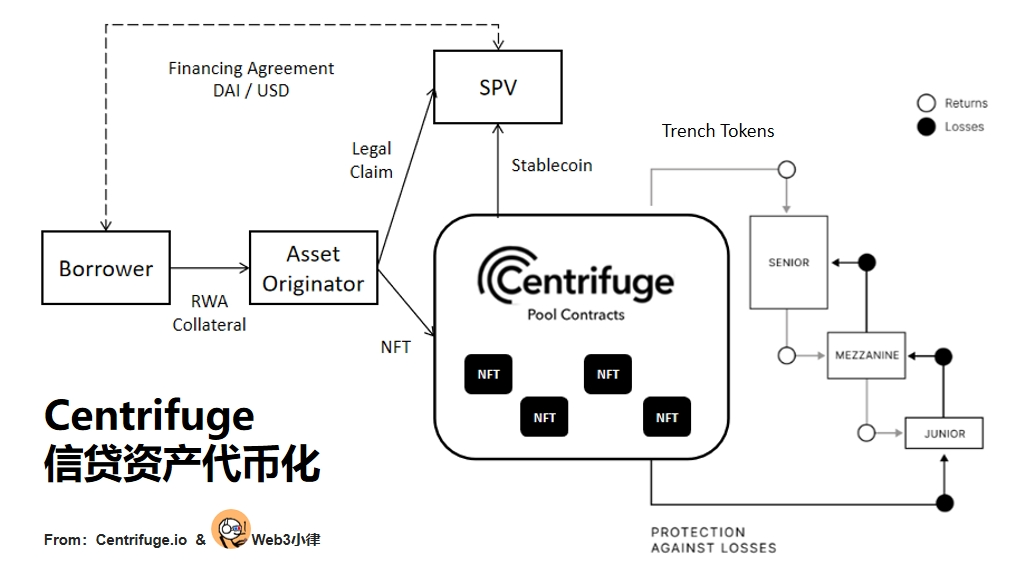
What I want to talk about more here is the Centrifuge Prime service, which aims to help crypto capital/DeFi protocols/DAO treasuries capture the value of real-world assets (such as risk-free returns on US Treasury bonds). Previously, the Aave community proposed on August 8, 2023, to work with Centrifuge to invest stablecoins from the Aave treasury in RWA assets to capture a risk-free return of 5% based on US Treasury RWA.

(POP: Anemoy Liquid Treasury Fund 1)
The Centrifuge Prime service is divided into two parts:
Step 1: Legal wrapping for on-chain DeFi protocols, such as establishing a dedicated legal entity for Aave—a Cayman Foundation. This legal entity can replace the unlimited liability of DAO members and serve as an independent entity to implement RWA value capture, governed and controlled by the Aave community, acting as a bridge between DeFi and TradiFi.
Step 2: Centrifuge establishes a dedicated asset pool for Anemoy Liquid Treasury Fund 1. Unlike previous asset pools with underlying credit assets (assets placed in SPV, generating NFTs collateralized in the corresponding Centrifuge asset pool), the underlying assets of this Anemoy Liquid Treasury Fund 1 asset pool are US Treasury bonds, which need to be tokenized directly by the Anemoy LTF fund holding the US Treasury assets.

(Anemoy Liquid Treasury Fund 1)
Anemoy LTF is a fund registered in BVI, which first tokenizes the fund through the Centrifuge protocol; then, Aave invests treasury funds in the corresponding Centrifuge asset pool of Anemoy LTF and generates fund token certificates; subsequently, the Centrifuge asset pool allocates the assets invested by the Aave treasury to the Anemoy LTF fund; finally, the Anemoy LTF fund conducts USD bond purchases through fund custody, brokers, and brings US Treasury bond returns onto the chain.
Similarly, Centrifuge helped the stablecoin project Frax Finance to capture off-chain asset returns of $20 million through the above-mentioned method.
4. Permissionless Integration of RWA and DeFi
We have seen that most RWA projects, including those covered in this article, as well as most projects in the market, are only targeted at single/limited funders, or in other words, only for qualified investors, and retail investors cannot participate. This is because of regulatory compliance and local securities laws. If retail investors were to participate, it would incur issuance costs similar to an IPO. Therefore, not every RWA platform that puts assets on-chain can be open to all users.
In our previous research report "RWA in Thousands of Words: Decoding the Current Implementation Path of RWA and Exploring the Development Logic of Future RWA-Fi," we can still see some projects that can combine with DeFi to create a permissionless path for retail investor participation.
For example, Ondo Finance & Flux Finance, Matrixdock & T Protocol's DeFi lending path, which uses restricted tokens requiring permission from qualified investors as collateral to establish a DeFi lending pool, allowing retail investors to deposit stablecoins into the DeFi lending pool and earn lending interest. In addition, there are also paths for interest-bearing stablecoins with Ondo & USDY, and MatrixDock & USDV, which use restricted tokens requiring permission from qualified investors as collateral to issue stablecoins, allowing retail investors to deposit stablecoins in exchange for interest-bearing stablecoins.
The composability of DeFi is self-evident, and we have also seen Pendle integrating RWA assets to achieve interest rate swaps. We are actively exploring the integration of RWA and DeFi and are currently building a platform for US Treasury RWA to explore the infinite possibilities of RWA based on this foundation.
5. Conclusion
Currently, the projects seen in the market can be considered as RWA 1.0 versions, addressing more of the off-chain asset-side financing needs (whether through Security Token Offering or through collateralized lending) and the on-chain fund-side investment needs (capturing low-risk, stable-yielding, scalable, real-world assets unrelated to crypto volatility is key).
RWA will also develop into more integrated 2.0 and 3.0 versions in the near future. In the meantime, it's important to be prepared.
免责声明:本文章仅代表作者个人观点,不代表本平台的立场和观点。本文章仅供信息分享,不构成对任何人的任何投资建议。用户与作者之间的任何争议,与本平台无关。如网页中刊载的文章或图片涉及侵权,请提供相关的权利证明和身份证明发送邮件到support@aicoin.com,本平台相关工作人员将会进行核查。




